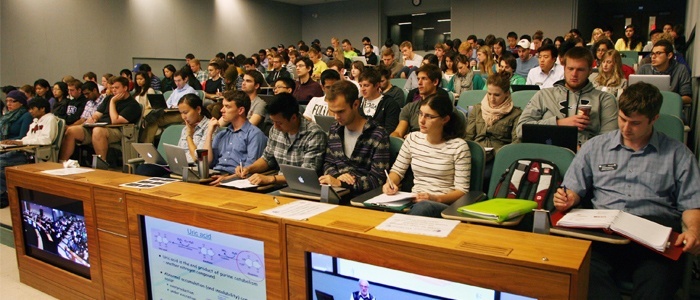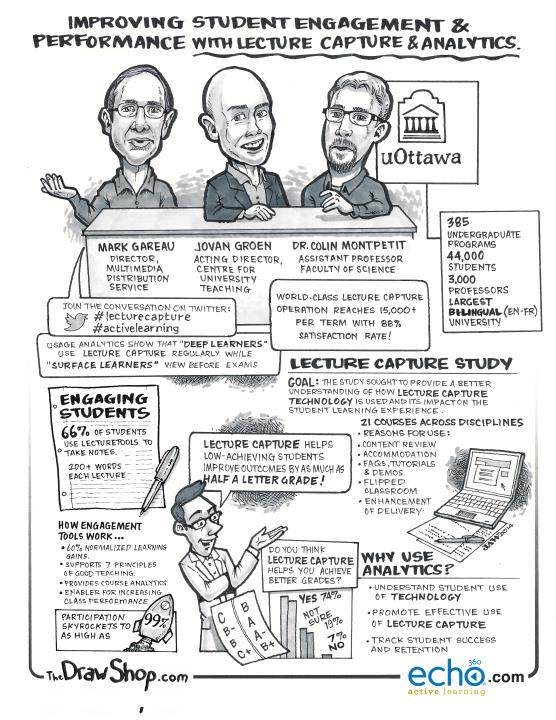Student Success: Learning Fearlessly Part 1

While student response systems (SRS) have been around well over a decade, it is not until recently that I have started taking advantage of their pedagogical benefits. In the span of time since my first implementation of SRS-associated peer-instruction approaches (4 years ago), SRS technology has greatly evolved from hand held clickers (with analogue transmission and antenna reception) to Bring-Your-Own-Device (BYOD) cloud-based classroom interaction systems. Undeniably, the evolution of cloud-based SRSs such LectureTools has opened the door to teaching and learning approaches that were previously not possible to implement or were limiting in nature. For example, the ability to ask questions using varying types of formats, including short answer questions, image quizzes, ordering, in addition to multiple choice questions via cloud-based systems support the efforts of educators to enhance the classroom experience. Additionally, built-in features such as “ask an anonymous question” and the “confused flag”, give students additional opportunities to communicate with their professor during class time. There are yet other features that empower professors to build a stronger learning community by creating seamless links between students and the professor.
Most research on the benefits of using SRSs in the classroom has shown that the wise use of such systems can help assess prior knowledge, poll student attitudes, confront common misconceptions, transform the way you demonstrate, test students’ understanding and retention, test conceptual understanding, facilitate discussion and peer instruction and increase classroom attendance. Research also shows that students become engaged and enjoy using the technology. I certainly had that experience after implementing LectureTools for the first time in my second year large enrolment course (3 Sections of approximately 200 students each) in Genetics during the 2014 winter session). Indeed, the experience has transformed my classroom into an active learning zone!
In a recent Echo360 webinar, I shared my experiences in using the course analytics in LectureTools to see how the use of the technology impacted student engagement.
- Participation rate: On a per lecture basis, the participation rate (based on the number of students submitting answers to questions I asked in class during a given class) was nearly 99%, decreasing to approximately 89% on days where students had a midterm that very same day or the day after. This was observed in my three sections of the course.
- # of students taking notes per lecture: On a per lecture basis, about 66% of the students in each of my three sections took notes via the note taking features of the program.
- # of words types by students per lecture: Measurement of the number of words typed on a per lecture basis revealed that the students typed about 350-500 words during lectures which were more traditional in nature, and fewer words on days where active engagement activities (e.g. many SRS questions were asked) were the primary mode of instruction.
- # of slides typed on by students: The average number of slides typed on by students was about 13 slides per lecture (note: I averaged 18 lecture slides per class). The number of slides typed on was the lowest on days where active engagement activities (e.g. many SRS questions were asked) were the primary mode of instruction.
- Students submitted 5-10 questions (using the ask an anonymous question feature) per class and indicated confusion (using the confusion flag) during problematic concepts. The questions that were submitted were answered either during class time or soon after.
Based on classroom observations, student comments, and efforts by our Teaching and Learning Support Services (TLSS) team to deploy LectureTools on our campus, I offer my thoughts on factors that have contributed to the high rate of student engagement in my classroom:
- Low cost: LectureTools is offered to students free of charge at uOttawa. Thanks to efforts by our TLSS team, this effectively takes advantage of the BYOD movement and eliminates additional costs students may have incurred had they been required to purchase access to the cloud-based system or physical clickers. Many students expressed their appreciation for having access to this cost-saving option. .
- Low-stakes participation: Approximately 10% of the overall grade was dedicated to participation marks. Students were given points for each answer submitted irrespective of correct or incorrect answers. If students answered 80% of the total questions asked throughout the term, they received full participation marks. If they participated to less than 80% submission rate, their participation mark was calculated as %submission rate/80. This approach provided flexibility to allow for absences or issues related to their devices for examples. Students really appreciated this feature. They could participate anonymously without fear of losing marks. Whether or not all students participate honestly is another matter, but most indicate that they do. With the solution being cloud-based, some students also valued the flexibility of being able to participate from a different location. Though I did not originally intend to use the solution in that way, I must admit that they are engaged in some manner!
- Students liked having the ability to submit their answers to questions anonymously and to communicate with the professor in private during class without exposing themselves publicly.
- Students felt that the instructor was listening to them during lectures. The different features offered by LectureTools enabled the professor to provide prompt feedback (e.g. address confusions and/or common questions/comments on the “ask your prof” feature, or share thoughts on student answers to “clicker questions.”
- Students felt that LectureTools helped make classes were more game-like. The opportunity to combine peer-instruction approaches with the various ways to ask questions using the solution made class fun, interactive, collaborative and intellectually challenging and made class time go by more quickly. Others indicated that the solution helped transform class time into a “study-zone.” Believe it or not, some students even expressed a wish for longer class sessions!
- A large proportion of the students appreciated the ability to take and keep notes within the LectureTools platform, especially being able to access them wherever they went.
- Finally, students also liked being engaged with their own devices as they could consult the Internet at the ready during classroom activities (I add here -. hopefully in relevant ways!)
In all respects, the features offered by LectureTools lived up to the expectations! This technology provides many mechanisms to help educators break out of the mold and establish learning communities within their classroom to fulfill their teaching and learning objectives. These include, but are not limited to, the ability to:
- Actively engage students during class periods
- Facilitate low-stakes testing and enable anonymous participation
- Receive real-time feedback and insights based on students’ questions and answers
- Quiz and question students using a multitude of question types
In my experience, all of these factors played a part in significantly increasing student engagement in my classes.
Be sure to read Part 2 and Part 3 of the blog for the complete story!
To learn more about Dr. Montpetit's success, view his Webinar archive:



